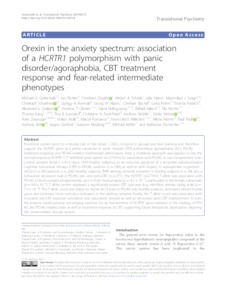Gottschalk, Michael G. and Richter, Jan and Ziegler, Christiane and Schiele, Miriam A. and Mann, Julia and Geiger, Maximilian J. and Schartner, Christoph and Homola, György A. and Alpers, Geoerg W. and Büchel, Christian and Fehm, Lydia and Fydrich, Thomas and Gerlach, Alexander L. and Gloster, Andrew T. and Helbig-Lang, Sylvia and Kalisch, Raffael and Kircher, Tilo and Lang, Thomas and Lonsdorf, Tina B. and Pané-Farré, Christiane A. and Ströhle, Andreas and Weber, Heike and Zwanzger, Peter and Arolt, Volker and Romanos, Marcel and Wittchen, Hans-Ulrich and Hamm, Alfons and Pauli, Paul and Reif, Andreas and Deckert, Jürgen and Neufang, Susanne and Höfler, Michael and Domschke, Katharina.
(2019)
Orexin in the anxiety spectrum: association of a HCRTR1 polymorphism with panic disorder/agoraphobia, CBT treatment response and fear-related intermediate phenotypes.
Translational Psychiatry, 9.
p. 75.
![[img]](https://edoc.unibas.ch/style/images/fileicons/application_pdf.png)  Preview |
|
PDF
- Published Version
Available under License CC BY (Attribution).
1125Kb |
Official URL: https://edoc.unibas.ch/73205/
Downloads: Statistics Overview
Abstract
Preclinical studies point to a pivotal role of the orexin 1 (OX1) receptor in arousal and fear learning and therefore suggest the HCRTR1 gene as a prime candidate in panic disorder (PD) with/without agoraphobia (AG), PD/AG treatment response, and PD/AG-related intermediate phenotypes. Here, a multilevel approach was applied to test the non-synonymous HCRTR1 C/T Ile408Val gene variant (rs2271933) for association with PD/AG in two independent case-control samples (total n = 613 cases, 1839 healthy subjects), as an outcome predictor of a six-weeks exposure-based cognitive behavioral therapy (CBT) in PD/AG patients (n = 189), as well as with respect to agoraphobic cognitions (ACQ) (n = 483 patients, n = 2382 healthy subjects), fMRI alerting network activation in healthy subjects (n = 94), and a behavioral avoidance task in PD/AG pre- and post-CBT (n = 271). The HCRTR1 rs2271933 T allele was associated with PD/AG in both samples independently, and in their meta-analysis (p = 4.2 x 10(-7)), particularly in the female subsample (p = 9.8 x 10(-9)). T allele carriers displayed a significantly poorer CBT outcome (e.g., Hamilton anxiety rating scale: p = 7.5 x 10(-4)). The T allele count was linked to higher ACQ sores in PD/AG and healthy subjects, decreased inferior frontal gyrus and increased locus coeruleus activation in the alerting network. Finally, the T allele count was associated with increased pre- CBT exposure avoidance and autonomic arousal as well as decreased post-CBT improvement. In sum, the present results provide converging evidence for an involvement of HCRTR1 gene variation in the etiology of PD/AG and PD/AG-related traits as well as treatment response to CBT, supporting future therapeutic approaches targeting the orexin-related arousal system.
| Faculties and Departments: | 07 Faculty of Psychology > Departement Psychologie > Health & Intervention > Clinical Psychology and Intervention Science (Gloster) |
|---|
| UniBasel Contributors: | Gloster, Andrew |
|---|
| Item Type: | Article, refereed |
|---|
| Article Subtype: | Research Article |
|---|
| Publisher: | Springer Nature |
|---|
| ISSN: | 2158-3188 |
|---|
| Note: | Publication type according to Uni Basel Research Database: Journal article |
|---|
| Language: | English |
|---|
| Identification Number: | |
|---|
| edoc DOI: | |
|---|
| Last Modified: | 18 Dec 2019 07:57 |
|---|
| Deposited On: | 18 Dec 2019 07:57 |
|---|
Repository Staff Only: item control page
